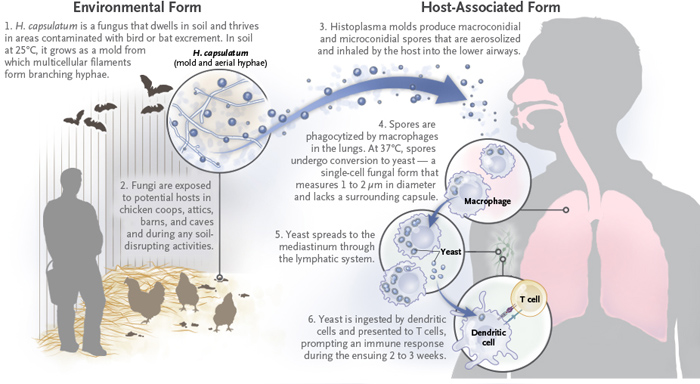
Histoplasmosis (say: hiss-toe-plaz-mo-sis) is an infection in your lungs caused by a fungus. Histoplasmosis is a common systemic mycosis with a primary pulmonary infection but with uncommon hematogenous dissemination, characterized by chronic infection of mucous membranes, skin, and reticuloendothelial organs (liver, bone marrow, and spleen).
Causes of Histoplasmosis
The fungus that causes histoplasmosis grows in the ground. Farming, gardening or any activity that disturbs the soil can let fungus spores get into the air. If you breathe in those spores, you can get the infection.
Symptoms of Histoplasmosis
- Cough
- Chills
- Sweats
- Fever
- Fatigue
- Muscle aches
- Weight loss
Diagnosis
Because most cases of histoplasmosis produce no symptoms, the condition can be difficult to diagnose. In addition to a physical exam, a physician may perform the following tests to confirm the diagnosis:
- Blood test
- Mucus test
- Urine test
- Chest X ray
Treatment
Systemic antimycotic therapy Non-lifethreatening infections and for those unable to tolerate amphotericin B: Itraconazole, 400 mg bid PO for 12 weeks; or fluconazole, 800 mg qd PO for 12 weeks. Life-threatening and meningeal infection: Amphotericin B given IV.
Secondary prophylaxis In HIV disease, itraconazole, 200 mg/d, or fluconazole, 400 mg/d for life.
Prevention
When any material contaminated with bird or bat guano is to be disturbed in an area of endemic histoplasmosis, personal protective equipment (respirators, eye protection, gloves, or protective clothing) should be used during potential recreational or occupational exposure. Information regarding prevention and control of histoplasmosis can be obtained from the CDC’s Division of Bacterial and Mycotic Diseases, National Center for Infectious Diseases.
References